Abstract
We investigated the relative activity at which fully occupied human beta 1- and beta 2-adrenergic receptors (beta 1AR and beta 2AR) activate the stimulatory G protein (Gs)/adenylyl cyclase (AC) system in isolated membranes. The receptors were cloned and coexpressed in permanent cell lines at beta 1/beta 2 ratios that varied from 1:2 to 3:1 and at total receptor abundance that ranged from 8 to 2200 fmol/mg of membrane protein. Cell lines expressing beta 1AR or beta 2AR alone were also obtained. Competitive inhibition of isoproterenol-stimulated AC activity by the beta 2-selective antagonist ICI 118551 showed in all cases that maximal stimulation elicited by beta 1AR was lower than when it was elicited by equivalent densities of beta 2AR. This was especially noticeable at limiting concentrations of receptor, where the beta 1AR-mediated effect was < 10% of that mediated by beta 2AR. At receptor concentrations > 1000 fmol/mg of protein, stimulation by beta 2AR appeared to reach a maximum, while stimulation by beta 1AR continued to increase, so that at 3200 fmol/mg, beta 1AR-stimulated activity was 80% of beta 2AR-stimulated activity. It is clear that the degree to which a given receptor system is able to activate the Gs/AC system depends not only on its abundance but also on an activity parameter determined by the nature of the receptor, which we refer to as receptor efficacy. For human beta ARs, this efficacy parameter is much lower for the beta 1 subtype than for its beta 2 counterpart. The more effective stimulation of AC through beta 2AR than through beta 1AR is an inherent property of the receptor and not the cell in which it is expressed.
Full text
PDF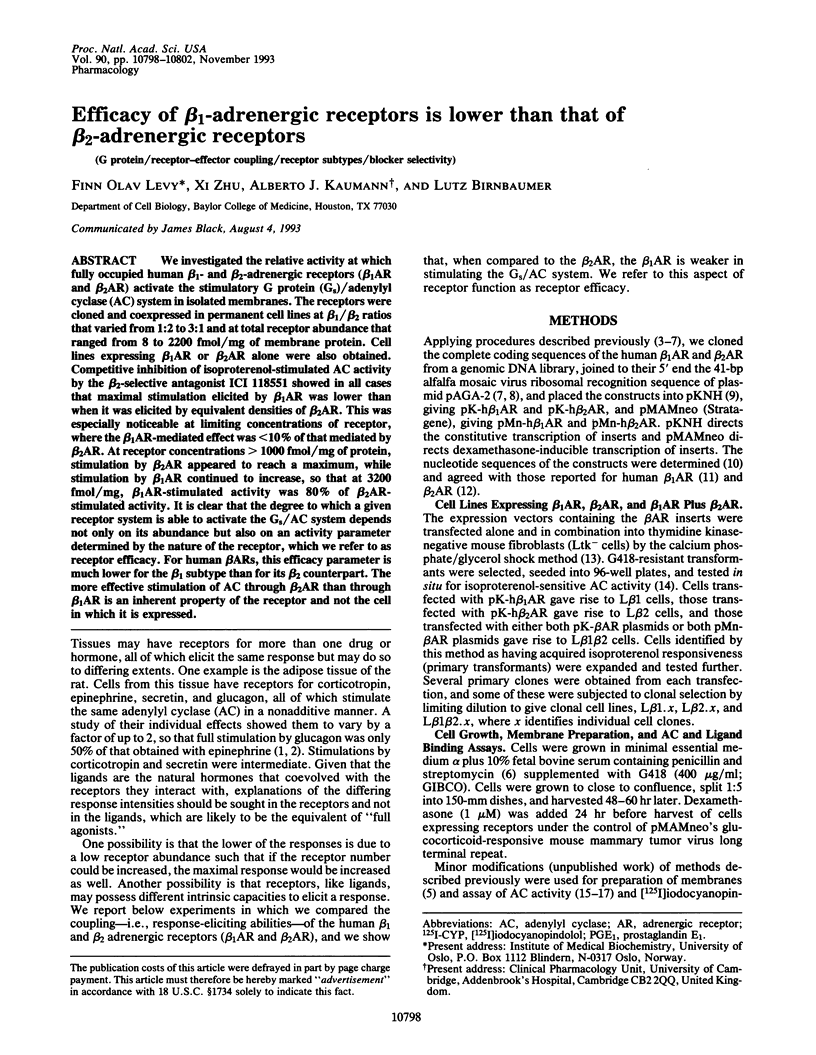
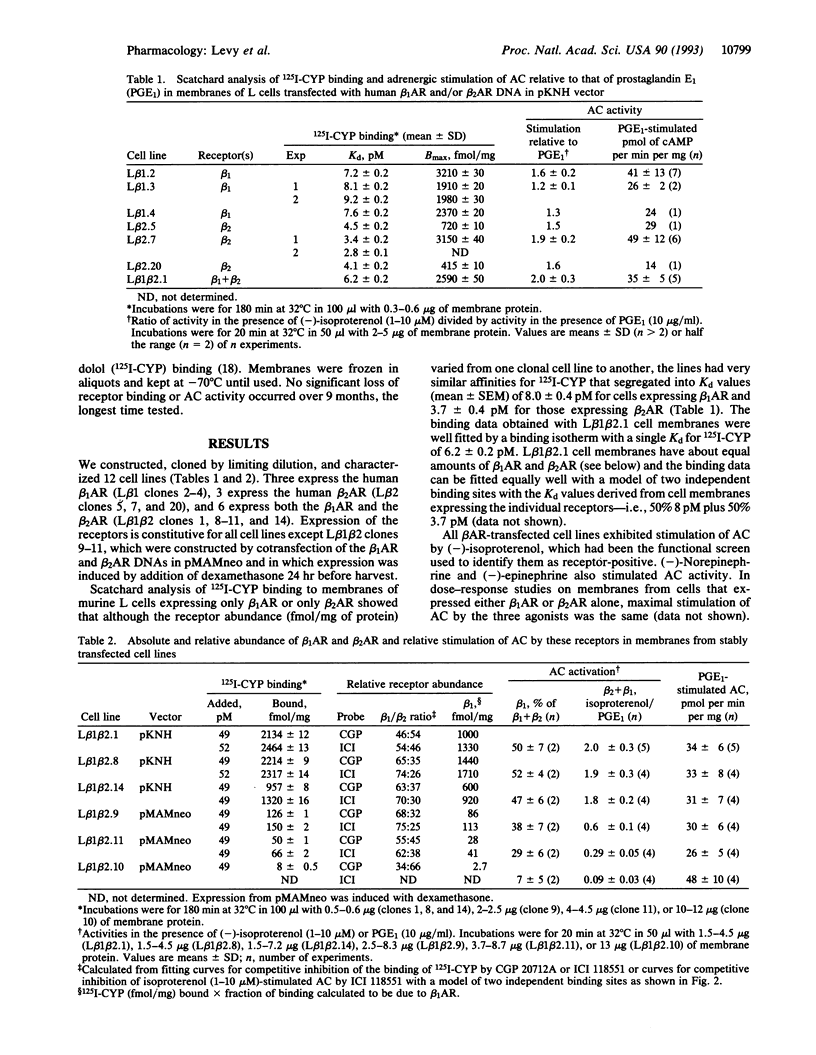
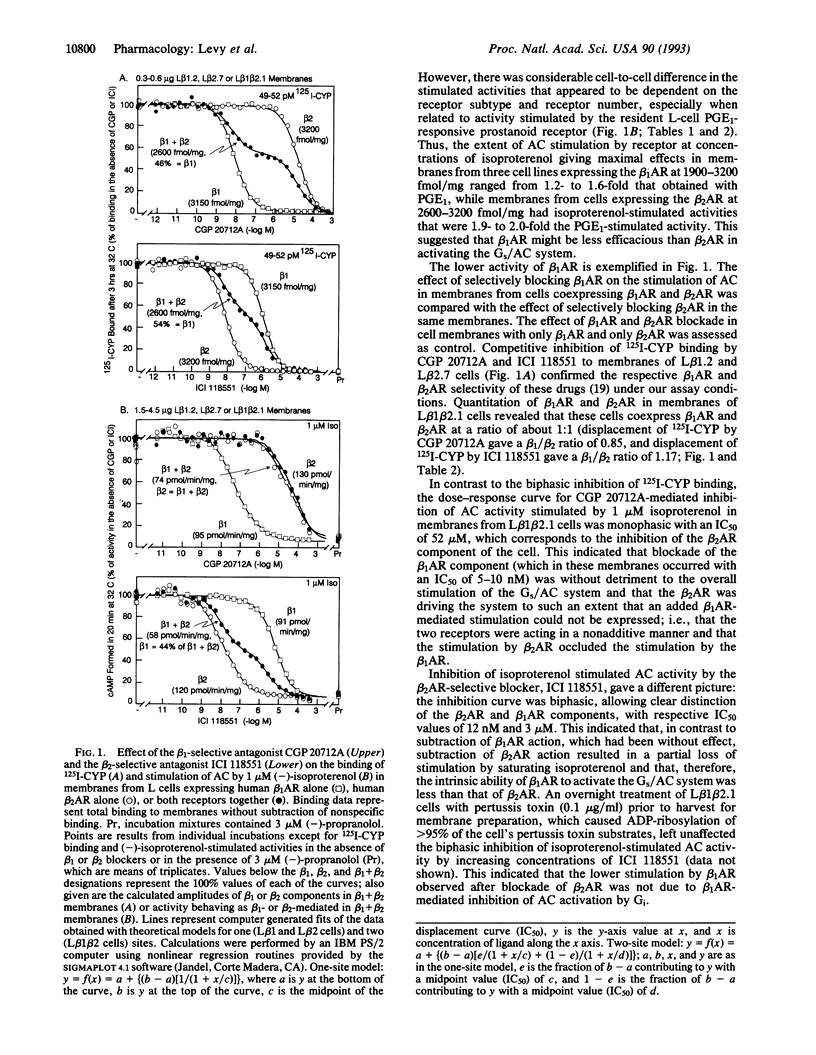
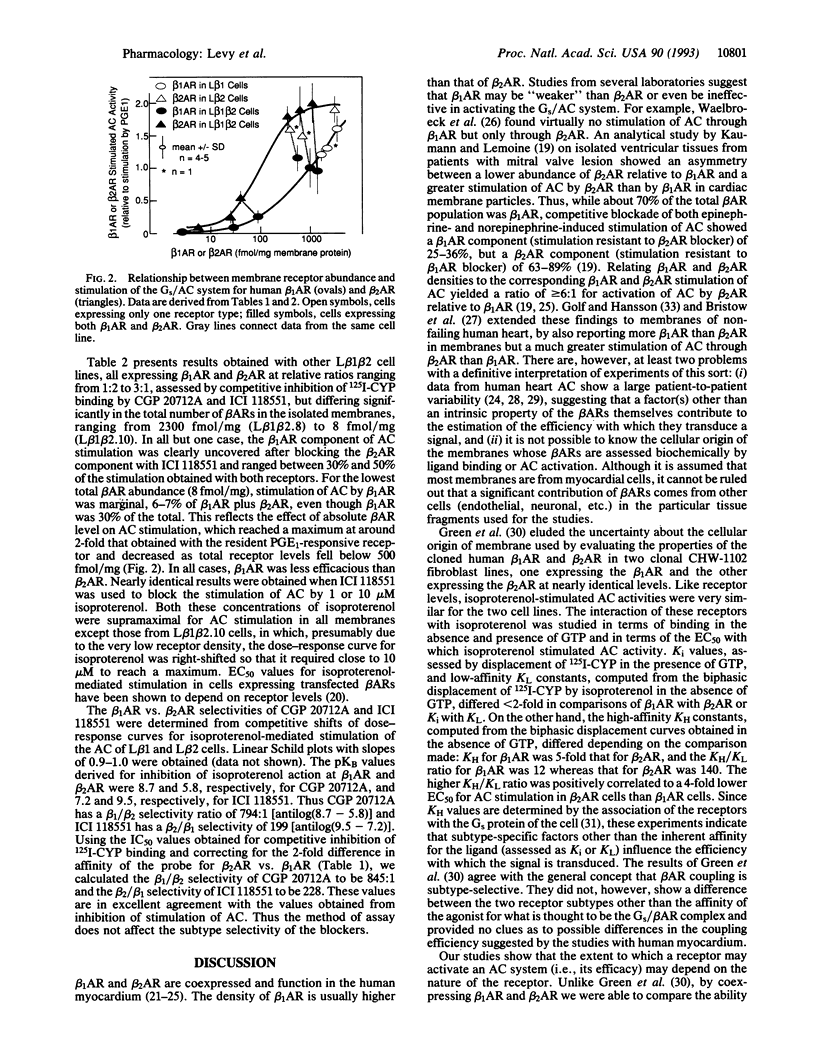
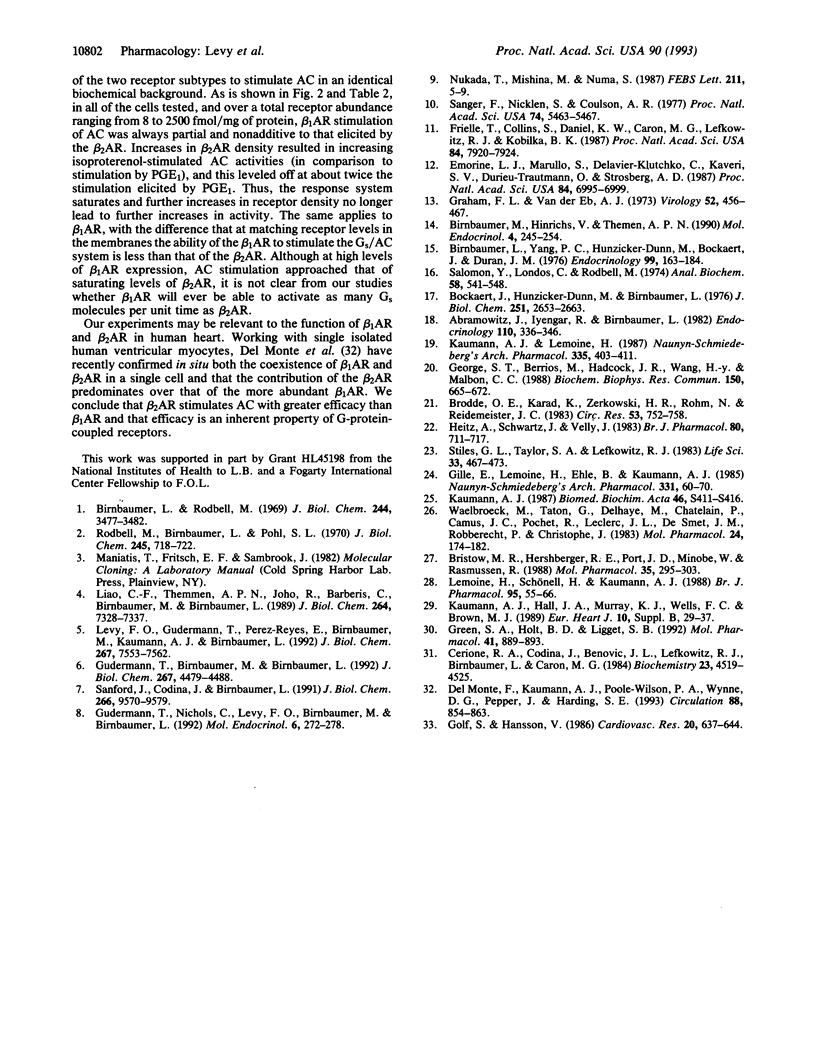
Selected References
These references are in PubMed. This may not be the complete list of references from this article.
- Abramowitz J., Iyengar R., Birnbaumer L. Guanine nucleotide and magnesium ion regulation of the interaction of gonadotropic and beta-adrenergic receptors with their hormones: a comparative study using a single membrane system. Endocrinology. 1982 Feb;110(2):336–346. doi: 10.1210/endo-110-2-336. [DOI] [PubMed] [Google Scholar]
- Birnbaumer L., Rodbell M. Adenyl cyclase in fat cells. II. Hormone receptors. J Biol Chem. 1969 Jul 10;244(13):3477–3482. [PubMed] [Google Scholar]
- Birnbaumer L., Yang P. C., Hunzicker-Dunn M., Bockaert J., Duran J. M. Adenylyl cyclase activities in ovarian tissues. I. Homogenization and conditions of assay in graafian follicles and corpora lutea of rabbits, rats, and pigs: regulation by ATP, and some comparative properties. Endocrinology. 1976 Jul;99(1):163–184. doi: 10.1210/endo-99-1-163. [DOI] [PubMed] [Google Scholar]
- Birnbaumer M., Hinrichs V., Themmen A. P., Themen A. P. Development and characterization of a mouse cell line expressing the human V2 vasopressin receptor gene. Mol Endocrinol. 1990 Feb;4(2):245–254. doi: 10.1210/mend-4-2-245. [DOI] [PubMed] [Google Scholar]
- Bockaert J., Hunzicker-Dunn M., Birnbaumer L. Hormone-stimulated desensitization of hormone-dependent adenylyl cyclase. Dual action of luteninizing hormone on pig graafian follicle membranes. J Biol Chem. 1976 May 10;251(9):2653–2663. [PubMed] [Google Scholar]
- Bristow M. R., Hershberger R. E., Port J. D., Minobe W., Rasmussen R. Beta 1- and beta 2-adrenergic receptor-mediated adenylate cyclase stimulation in nonfailing and failing human ventricular myocardium. Mol Pharmacol. 1989 Mar;35(3):295–303. [PubMed] [Google Scholar]
- Brodde O. E., Karad K., Zerkowski H. R., Rohm N., Reidemeister J. C. Coexistence of beta 1- and beta 2-adrenoceptors in human right atrium. Direct identification by (+/-)-[125I]iodocyanopindolol binding. Circ Res. 1983 Dec;53(6):752–758. doi: 10.1161/01.res.53.6.752. [DOI] [PubMed] [Google Scholar]
- Cerione R. A., Codina J., Benovic J. L., Lefkowitz R. J., Birnbaumer L., Caron M. G. The mammalian beta 2-adrenergic receptor: reconstitution of functional interactions between pure receptor and pure stimulatory nucleotide binding protein of the adenylate cyclase system. Biochemistry. 1984 Sep 25;23(20):4519–4525. doi: 10.1021/bi00315a003. [DOI] [PubMed] [Google Scholar]
- Emorine L. J., Marullo S., Delavier-Klutchko C., Kaveri S. V., Durieu-Trautmann O., Strosberg A. D. Structure of the gene for human beta 2-adrenergic receptor: expression and promoter characterization. Proc Natl Acad Sci U S A. 1987 Oct;84(20):6995–6999. doi: 10.1073/pnas.84.20.6995. [DOI] [PMC free article] [PubMed] [Google Scholar]
- Frielle T., Collins S., Daniel K. W., Caron M. G., Lefkowitz R. J., Kobilka B. K. Cloning of the cDNA for the human beta 1-adrenergic receptor. Proc Natl Acad Sci U S A. 1987 Nov;84(22):7920–7924. doi: 10.1073/pnas.84.22.7920. [DOI] [PMC free article] [PubMed] [Google Scholar]
- George S. T., Berrios M., Hadcock J. R., Wang H. Y., Malbon C. C. Receptor density and cAMP accumulation: analysis in CHO cells exhibiting stable expression of a cDNA that encodes the beta 2-adrenergic receptor. Biochem Biophys Res Commun. 1988 Jan 29;150(2):665–672. doi: 10.1016/0006-291x(88)90443-3. [DOI] [PubMed] [Google Scholar]
- Gille E., Lemoine H., Ehle B., Kaumann A. J. The affinity of (-)-propranolol for beta 1- and beta 2-adrenoceptors of human heart. Differential antagonism of the positive inotropic effects and adenylate cyclase stimulation by (-)-noradrenaline and (-)-adrenaline. Naunyn Schmiedebergs Arch Pharmacol. 1985 Oct;331(1):60–70. doi: 10.1007/BF00498852. [DOI] [PubMed] [Google Scholar]
- Golf S., Hansson V. Effects of beta blocking agents on the density of beta adrenoceptors and adenylate cyclase response in human myocardium: intrinsic sympathomimetic activity favours receptor upregulation. Cardiovasc Res. 1986 Sep;20(9):637–644. doi: 10.1093/cvr/20.9.637. [DOI] [PubMed] [Google Scholar]
- Graham F. L., van der Eb A. J. A new technique for the assay of infectivity of human adenovirus 5 DNA. Virology. 1973 Apr;52(2):456–467. doi: 10.1016/0042-6822(73)90341-3. [DOI] [PubMed] [Google Scholar]
- Green S. A., Holt B. D., Liggett S. B. Beta 1- and beta 2-adrenergic receptors display subtype-selective coupling to Gs. Mol Pharmacol. 1992 May;41(5):889–893. [PubMed] [Google Scholar]
- Gudermann T., Birnbaumer M., Birnbaumer L. Evidence for dual coupling of the murine luteinizing hormone receptor to adenylyl cyclase and phosphoinositide breakdown and Ca2+ mobilization. Studies with the cloned murine luteinizing hormone receptor expressed in L cells. J Biol Chem. 1992 Mar 5;267(7):4479–4488. [PubMed] [Google Scholar]
- Gudermann T., Nichols C., Levy F. O., Birnbaumer M., Birnbaumer L. Ca2+ mobilization by the LH receptor expressed in Xenopus oocytes independent of 3',5'-cyclic adenosine monophosphate formation: evidence for parallel activation of two signaling pathways. Mol Endocrinol. 1992 Feb;6(2):272–278. doi: 10.1210/mend.6.2.1314958. [DOI] [PubMed] [Google Scholar]
- Heitz A., Schwartz J., Velly J. Beta-adrenoceptors of the human myocardium: determination of beta 1 and beta 2 subtypes by radioligand binding. Br J Pharmacol. 1983 Dec;80(4):711–717. doi: 10.1111/j.1476-5381.1983.tb10062.x. [DOI] [PMC free article] [PubMed] [Google Scholar]
- Kaumann A. J. Adrenaline and noradrenaline increase contractile force of human ventricle through both beta 1- and beta 2-adrenoceptors. Biomed Biochim Acta. 1987;46(8-9):S411–S416. [PubMed] [Google Scholar]
- Kaumann A. J., Hall J. A., Murray K. J., Wells F. C., Brown M. J. A comparison of the effects of adrenaline and noradrenaline on human heart: the role of beta 1- and beta 2-adrenoceptors in the stimulation of adenylate cyclase and contractile force. Eur Heart J. 1989 Jun;10 (Suppl B):29–37. doi: 10.1093/eurheartj/10.suppl_b.29. [DOI] [PubMed] [Google Scholar]
- Kaumann A. J., Lemoine H. Beta 2-adrenoceptor-mediated positive inotropic effect of adrenaline in human ventricular myocardium. Quantitative discrepancies with binding and adenylate cyclase stimulation. Naunyn Schmiedebergs Arch Pharmacol. 1987 Apr;335(4):403–411. doi: 10.1007/BF00165555. [DOI] [PubMed] [Google Scholar]
- Lemoine H., Schönell H., Kaumann A. J. Contribution of beta 1- and beta 2-adrenoceptors of human atrium and ventricle to the effects of noradrenaline and adrenaline as assessed with (-)-atenolol. Br J Pharmacol. 1988 Sep;95(1):55–66. doi: 10.1111/j.1476-5381.1988.tb16548.x. [DOI] [PMC free article] [PubMed] [Google Scholar]
- Levy F. O., Gudermann T., Perez-Reyes E., Birnbaumer M., Kaumann A. J., Birnbaumer L. Molecular cloning of a human serotonin receptor (S12) with a pharmacological profile resembling that of the 5-HT1D subtype. J Biol Chem. 1992 Apr 15;267(11):7553–7562. [PubMed] [Google Scholar]
- Liao C. F., Themmen A. P., Joho R., Barberis C., Birnbaumer M., Birnbaumer L. Molecular cloning and expression of a fifth muscarinic acetylcholine receptor. J Biol Chem. 1989 May 5;264(13):7328–7337. [PubMed] [Google Scholar]
- Nukada T., Mishina M., Numa S. Functional expression of cloned cDNA encoding the alpha-subunit of adenylate cyclase-stimulating G-protein. FEBS Lett. 1987 Jan 19;211(1):5–9. doi: 10.1016/0014-5793(87)81263-2. [DOI] [PubMed] [Google Scholar]
- Rodbell M., Birnbaumer L., Pohl S. L. Adenyl cyclase in fat cells. 3. Stimulation by secretin and the effects of trypsin on the receptors for lipolytic hormones. J Biol Chem. 1970 Feb 25;245(4):718–722. [PubMed] [Google Scholar]
- Salomon Y., Londos C., Rodbell M. A highly sensitive adenylate cyclase assay. Anal Biochem. 1974 Apr;58(2):541–548. doi: 10.1016/0003-2697(74)90222-x. [DOI] [PubMed] [Google Scholar]
- Sanford J., Codina J., Birnbaumer L. Gamma-subunits of G proteins, but not their alpha- or beta-subunits, are polyisoprenylated. Studies on post-translational modifications using in vitro translation with rabbit reticulocyte lysates. J Biol Chem. 1991 May 25;266(15):9570–9579. [PubMed] [Google Scholar]
- Sanger F., Nicklen S., Coulson A. R. DNA sequencing with chain-terminating inhibitors. Proc Natl Acad Sci U S A. 1977 Dec;74(12):5463–5467. doi: 10.1073/pnas.74.12.5463. [DOI] [PMC free article] [PubMed] [Google Scholar]
- Stiles G. L., Taylor S., Lefkowitz R. J. Human cardiac beta-adrenergic receptors: subtype heterogeneity delineated by direct radioligand binding. Life Sci. 1983 Aug 1;33(5):467–473. doi: 10.1016/0024-3205(83)90796-8. [DOI] [PubMed] [Google Scholar]
- Waelbroeck M., Taton G., Delhaye M., Chatelain P., Camus J. C., Pochet R., Leclerc J. L., De Smet J. M., Robberecht P., Christophe J. The human heart beta-adrenergic receptors. II. Coupling of beta 2-adrenergic receptors with the adenylate cyclase system. Mol Pharmacol. 1983 Sep;24(2):174–182. [PubMed] [Google Scholar]
- del Monte F., Kaumann A. J., Poole-Wilson P. A., Wynne D. G., Pepper J., Harding S. E. Coexistence of functioning beta 1- and beta 2-adrenoceptors in single myocytes from human ventricle. Circulation. 1993 Sep;88(3):854–863. doi: 10.1161/01.cir.88.3.854. [DOI] [PubMed] [Google Scholar]


